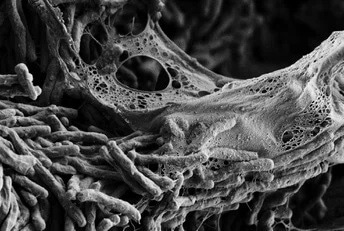According to a study published today in eLife, scientists found how the bacterium that induces tuberculosis (TB) could quickly adapt in response to new environments.
 Mycobacterium tuberculosis cells within a biofilm. Image Credit: John Kernien (CC BY 4.0).
Mycobacterium tuberculosis cells within a biofilm. Image Credit: John Kernien (CC BY 4.0).
Mycobacterium tuberculosis (M. tuberculosis), like other bacteria, can form complicated structures named biofilms, which enable bacterial cells to fight back stress factors like antibiotics and immune cells.
The research group progressed populations of M. tuberculosis in the lab for this research and discovered that it could form thick biofilms due to mutations in genetic regions that cause numerous changes to occur at once. These research results may assist in the development of antibiotics that target biofilm growth.
As the second leading cause of death due to infectious disease worldwide, tuberculosis (TB) is a major health concern, and new tactics for diagnosing, treating, and managing the infection are urgently needed.
TB remains a challenging infection to treat due to the bacterium’s ability to persist in the face of antibiotic and immune pressure, and to acquire novel drug resistances.”
Madison Youngblom, Graduate Student, University of Wisconsin-Madison
Youngblom, a student at Caitlin Pepperell’s Lab, was also a study co-first author alongside Tracy Smith, New York Genome Center, New York City, US.
To better treat and control TB, we need to understand the sources of the bacterium’s robustness and identify its vulnerabilities. We wanted to learn more about how it is able to form biofilms by discovering the genes and genetic regions involved in biofilm growth, as well as how the bacterium evolves in response to changes in its environment.”
Madison Youngblom, Graduate Student, University of Wisconsin-Madison
To accomplish this, the researchers used M. tuberculosis experimental transformation, a valuable asset for enlightening the bacterium’s abilities and vulnerabilities that have yielded valuable insights into the fundamental processes that direct its transformation. Under selective pressure, researchers developed six strongly linked M. tuberculosis strains to grow as a biofilm.
They photographed the biofilm at regular intervals and characterized its growth using four criteria: how much liquid surface the biofilm coated, its connection to and growth up the sides of the dish, how thick the biofilm grew, and the consistency of growth (compared to discontinuous patches of growth).
Their findings revealed that each strain was capable of rapidly adapting to environmental pressure, resulting in the formation of a thicker and thus more rigorous biofilm. RegX3, phoP, embR, and Rv2488c were among the genetic regions that mutated during the trial, resulting in biofilm growth.
These regulators control the activity of multiple genes, meaning a single mutation can cause many changes to occur in one go. This is an efficient process that we observed when we looked at the different characteristics of the bacteria, such as their cell size and growth rate.”
Madison Youngblom, Graduate Student, University of Wisconsin-Madison
Furthermore, the researchers discovered evidence that the genetic heritage of the parent strain of M. tuberculosis had an effect on the growth promotion of biofilms. This means that relationships between biological factors may play a significant role in M. tuberculosis adaptation to new environments.
“Bacteria are prone to growing as biofilms in many contexts, including the infection of humans and other hosts, and during colonization of natural and built environments,” says senior author Caitlin Pepperell, Principal Investigator at the University of Wisconsin-Madison.
Caitlin Pepperell adds, “In a medical context, the insights gained from our work could be used to explore potential new antibiotics that are better able to attack bacteria that grow this way. We imagine such biofilm-directed therapies for TB would likely be add-ons to conventional therapy to help shorten and simplify current treatment strategies.”
Source:
Journal reference:
Smith, T. M., et al. (2022) Rapid adaptation of a complex trait during experimental evolution of Mycobacterium tuberculosis. eLife. doi.org/10.7554/eLife.78454.